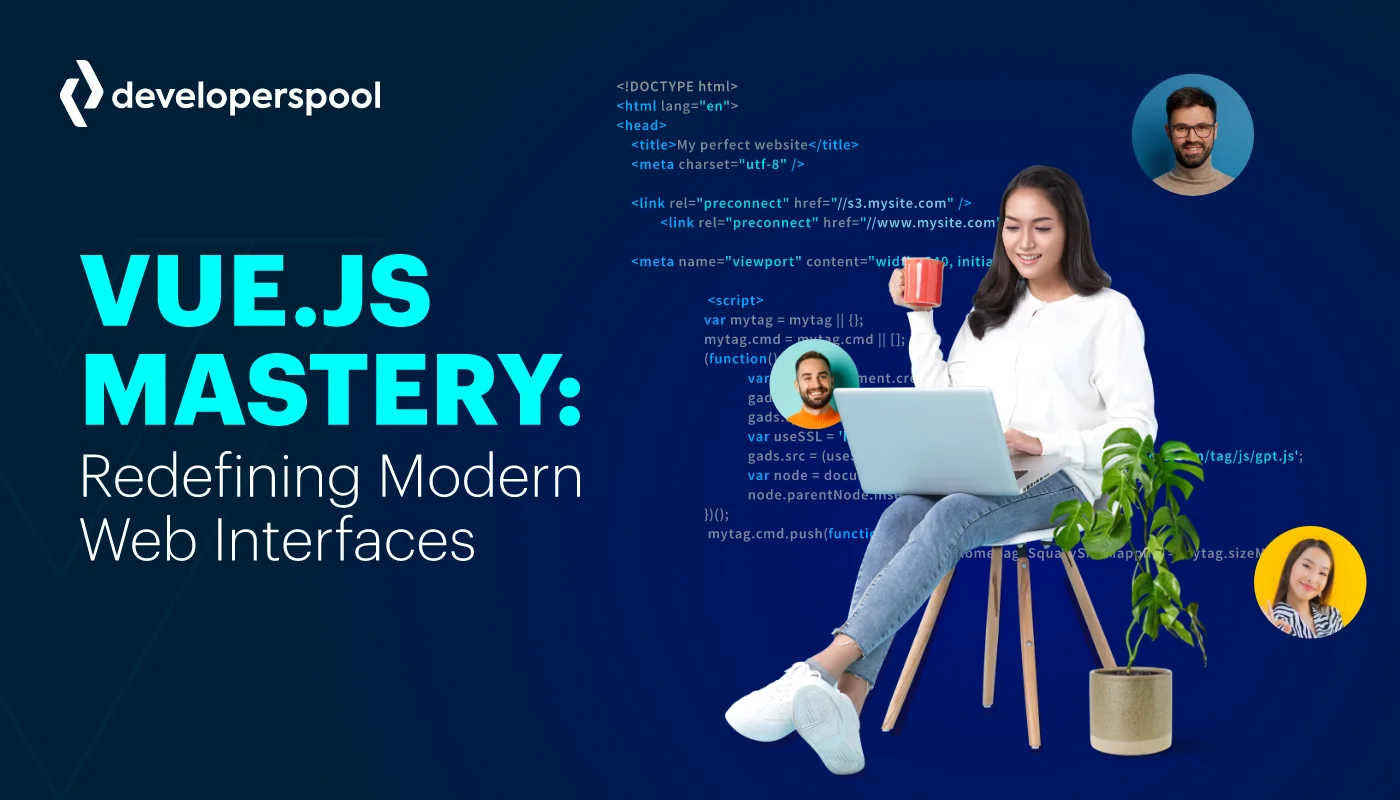Impact of Vue.JS Developers on Modern Web Design
- May 9, 2024
- 13 mins
- 24.3k

The appearance of a website or an app plays a crucial role in influencing user decisions. Did you know that approximately 70% of user’s decision to stay on a platform is based on its design? Therefore, to grab and keep user attention, it’s essential to create interfaces (UIs) that are not only visually appealing but also user-friendly. In this blog, we’ll talk about Vue.js, a popular JavaScript framework, and how impactful Vue.js developers on modern web design, the way today’s websites and apps appear and feel.
Why Good Design Is Important for Websites?
An effective user interface (UI) serves as a crucial connection between users and digital platforms, influencing their experience and perception of a brand on websites or apps. The way users navigate a site directly impacts their satisfaction and overall impression.
Vue.js, a JavaScript framework, is gaining popularity among web developers for its ability to simplify the creation of interactive and dynamic UIs. What makes Vue.js stand out is its balance of flexibility and structure, catering to developers of varying skill levels. Its user-friendly design and powerful features are making Vue.js a preferred choice for front-end development, shaping the appearance and functionality of websites and apps.
As you continue reading, you’ll discover how Vue.js empowers developers to craft impressive user interfaces and explore the numerous benefits it brings to creating exceptional web experiences.
What is Vue.js?
Vue.js is a progressive JavaScript framework designed specifically for building user interfaces (UIs). It seamlessly integrates with standard HTML, CSS, and JavaScript, offering a powerful and flexible approach to web development.
Vue.js simplifies the process of building web applications by introducing a framework that breaks down the user interface into reusable components. These components serve to keep the code organized and easily maintainable.
Unlike traditional approaches where developers have to instruct the computer precisely on updating web pages, Vue.js operates differently. Instead, you just describe how you want the page to appear, and Vue.js handles the technical aspects, streamlining the development process.
A notable advantage of Vue.js is its automatic updating feature. When you modify the data within your application, the webpage seamlessly adjusts to reflect those changes. This makes sure everything stays in sync, so you don’t have to do a lot of extra work manually during development.
Key Features and Benefits of Vue.js

- Easy to Learn: Vue.js is simple and easy to understand. If you know basic HTML, CSS, and JavaScript, you can start making user interfaces with Vue.js quickly.
- Use of Components: It lets you build user interfaces using reusable components. This makes complex interfaces easier to manage and maintain.
- Automatic Updates: Vue.js has a great feature that automatically updates the user interface when the data it’s based on changes. This means you don’t have to manually update the interface, making it more dynamic and responsive.
- Two-Way Data Binding: Vue.js makes it easy to manage data by linking the user interface and the data model. Any changes in one will automatically update the other, which simplifies data flow and reduces extra code.
- Versatile: Vue.js can be used in many ways, from improving static HTML pages to building complete single-page applications. This lets developers choose the best approach for their project.
- Supportive Community: Vue.js has a large and active community that provides many libraries, tools, and resources. This gives developers lots of options to add more features and capabilities to their applications.
The Role of Vue.js in Web Design
Vue.js has become a go-to tool for web designers, allowing them to craft dynamic, interactive, and captivating user interfaces (UIs). This JavaScript framework is lightweight and versatile, providing numerous benefits compared to conventional web development methods. It has gained popularity as a preferred choice for contemporary web design.

Here’s how Vue.js plays a key role in web design:
Vue.js is a powerful tool in modern web design because of its unique features that make development easier and improve user experiences. One key strength is its reactive data binding, which automatically updates the user interface when data changes, making development faster and keeping everything in sync.
Another important aspect is Vue.js’s component-based architecture. This encourages designers to create small, reusable parts that can be combined to build complex user interfaces. This not only makes the code easier to maintain but also ensures consistency and scalability across different projects.
Vue.js is especially good for building Single-Page Applications (SPAs), which provide a smoother and more responsive user experience. SPAs load a single page initially and then update content dynamically without reloading the whole page, making the website feel more like an app.
Additionally, Vue.js allows designers to add interactive elements to their interfaces easily. Features like animations, transitions, and custom events make it possible to create engaging user experiences that go beyond what traditional web design can offer.
The Impact of Vue.js Developers on Modern Web Design
Vue.js developers are reshaping the web design scene by:
- Setting higher UI standards: Their skillset enables the development of visually stunning, easy-to-use, and dynamic user interfaces that enhance the overall web experience.
- Pushing design boundaries: Vue.js empowers developers to explore new design patterns and functionalities, fostering more creative and engaging web interfaces.
- Enhancing development efficiency: By utilizing Vue.js’s features, developers can construct intricate UIs swiftly and with less code, leading to reduced development costs and quicker time to market.
Real-world examples of websites using Vue.js
- Netflix: Uses Vue.js for various interactive elements on their website, like personalized recommendations and user profiles.
- Grammarly: Leverages Vue.js to build a dynamic and user-friendly interface for their grammar checking and writing enhancement tool.
- GitLab: Utilizes Vue.js for various components within their collaborative coding platform, including code editors and issue trackers.
Reasons to Choose Vue.js Framework
Vue.js is a popular JavaScript framework for building user interfaces and single-page applications. It offers a balance between simplicity and flexibility, making it a good choice for both beginners and experienced developers. Here are some reasons why you might choose Vue.js for your next project:
- Easy to Learn
Vue.js has a gentle learning curve, thanks to its well-documented syntax and intuitive API. It doesn’t require extensive knowledge of complex JavaScript concepts like virtual DOM (Document Object Model) or build tools, making it an excellent choice for beginners.
- Versatile
Vue.js can be used to build a wide range of applications, from small single-page applications to large-scale enterprise applications. It can be used incrementally to enhance existing projects or as a complete framework for building new ones.
- Performance
Vue.js applications are known for their performance and responsiveness. It utilizes a virtual DOM (Document Object Model) similar to React, which helps keep the UI up-to-date efficiently.
- Flexibility
Vue.js offers a high degree of flexibility. It can be used with a variety of build tools, libraries, and frameworks, allowing you to customize your development process and choose the tools that best suit your needs.
- Large Community and Ecosystem
Vue.js has a large and active community of developers. This means you’ll find plenty of resources, tutorials, and libraries to help you learn and build applications. The community is also very helpful, so you’re likely to find answers to your questions if you get stuck.
Comparison with Other Frameworks
Here’s a brief comparison of Vue.js with other popular JavaScript frameworks like React and Angular:
To make table lines visible in WordPress, you can add some CSS styles to the HTML table code. Here’s the HTML with the CSS styles included:
| Feature | React | Angular | Vue.js |
| Type | UI library | Full-fledged framework | Progressive framework |
| Learning Curve | Moderate | Steeper | Gentle |
| Performance | Excellent | Excellent | Excellent |
| Flexibility | High | Lower | High |
| Community & Ecosystem | Large and active | Large and active | Large and active |
The best framework for your project depends on your specific needs and preferences. Here are
some general guidelines:
- Choose React if you need a highly flexible library for building complex user interfaces and have a strong understanding of JavaScript concepts.
- Choose Angular if you need a full-fledged framework with a strong structure and built-in features for enterprise-scale applications.
- Choose Vue.js if you want a balance between simplicity, flexibility, and performance, and are looking for a framework that is easy to learn and use.
Ultimately, the best way to decide which framework is right for you is to experiment with each one and see which one you find most comfortable and productive to use.
Future of Web Design with Vue.JS
Vue.js, an open-source JavaScript framework, has been gaining attention for its effectiveness in building scalable, maintainable, and resource-efficient applications. Here are some predictions on how Vue.js might influence future trends in web design:
- Component-based Architecture: Vue.js strongly emphasizes the view layer and supports a component-based architecture. This allows large and complex sections of code to be broken up into smaller components, promoting encapsulation, readability, simplicity, and separation of concerns.
- Ease of Use: Vue.js is known for its low learning curve, elegant programming patterns, and comprehensive documentation. This makes it a strong choice for both beginners and experienced developers, potentially influencing more user-friendly and accessible web design practices.
- Performance Optimization: Vue.js has a relatively small bundle size compared to competing frameworks, making it a performant choice for load time. This can positively impact an application’s performance, Search Engine Optimization (SEO), and user experience.
- Integration with Modern Tools: Vue.js supports numerous front-end build tools with little-to-no configuration. This could lead to more efficient and streamlined development processes in the future.
- Adoption by Large Organizations: As Vue.js continues to gain popularity, more companies are adopting the framework into their organizations. This could influence future trends as more large-scale applications are built using Vue.js.
- Innovation with Vue.js: The Vue.js team is continuously working on new features and improvements. For instance, the most significant innovation currently being developed in the Vue ecosystem is the Vapor mode. This technology can be activated for specific components that necessitate optimization.
- Continued Support for the Option API: There are no plans to remove the option API in the future, as maintaining both approaches — Composition API and Option API — is very manageable. This ensures that developers have the flexibility to choose the approach that best suits their project needs.
Vue.js is poised to continue influencing web design trends with its focus on component-based architecture, ease of use, performance optimization, and continuous innovation. As more developers and organizations adopt Vue.js, we can expect to see these trends become more prevalent in the future.
Conclusion: A Brighter UI Future with Vue.js
Vue.js empowers developers to craft exceptional user interfaces, shaping the future of web design. From interactive features and single-page applications to progressive web apps and a focus on developer experience, Vue.js offers a comprehensive toolkit for building modern, engaging, and user-centric web experiences. As the Vue ecosystem and community continue to flourish, we can expect even more innovative and captivating UIs to grace the digital landscape.
Frequently Asked Questions
Look for a developer with a strong understanding of JavaScript, experience with Vue.js and its ecosystem (Vuex, Vue Router), familiarity with HTML/CSS, and knowledge of modern front-end development tools. It’s also important that they understand your project requirements and have good problem-solving skills.
Vue.js is a great choice when you need a lightweight, efficient, and flexible framework for building single-page applications (SPAs). It’s also a good choice for projects that require a fast rendering speed and a small bundle size.
However, if your project requires server-side rendering or if you’re working with a team that has more experience with another framework like React or Angular, then Vue.js might not be the best choice.
With Vue.js, you can develop a variety of web applications, including single-page applications (SPAs), progressive web apps (PWAs), static websites, multi-page applications (MPAs), and even complex web applications with state management.
Vue.js is in demand because it’s easy to learn and use, it’s lightweight and efficient, and it provides a lot of flexibility for developers. It also has a strong community and ecosystem, which means there are plenty of resources and third-party libraries available.
Vue.js is used for building user interfaces in web applications. It provides a framework for building components, managing state, routing, and more. It’s often used for building single-page applications, but it can also be used in multi-page applications or even just to add interactivity to a small part of an existing website.
Recent Blogs
Stay ahead with the latest tech trends with our informative blogs and
insider guide to hire the best talent.






